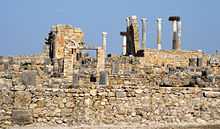Rabat Archaeological Museum
Rabat Archaeological Museum (Musée Archéologique) is an archaeological museum in Rabat, Morocco. Opened in 1932, it contains the most extensive collection of archaeological artifacts found in Morocco.[1] It contains prehistoric and pre-Islamic collections including an extensive collection of objects uncovered by archaeologists working in Volubilis, Banasa and Thamusida, and were first put on display in 1930-1932. This includes human remains from the middle palaeolithic period (probably Neanderthals) to the neolithic (4000 BC).[2] A further find in 1957 saw the museum expand considerably, after which it became a National Museum and it has housed the National Museum collections since 1986.[2] Pre-Roman and Roman civilisations are well represented in the museum with a number of notable Hellenistic-style bronzes such as the Dog of Volubilis, and the marble 'Ephebe Crowned With Ivy and Head of a Young Berber.[3]
Prehistoric cultures
On the ground floor of the museum is an extensive collection of stone artifacts from prehistoric cultures. On display are a number of tools, arrows, axes, swords, items of pottery, altars and sarcophagi and polished stones and stelae carved with inscriptions. The floor also has a number of tomb fragments and rock carvings. It covers Acheulian culture from sites such as Sidi Abderrahmane and Daya el-Hamra, Pebble culture from sites such as Arboua, Douar Doum and Casablanca, and Mousterian and Aterian cultures dating back to 4000 BC.[3] The museum also contains the oldest human remains found in Morocco.[3] The Neolithic culture of Morocco, based on agriculture and livestock and evolving technologies and rock art, has been found in the caves in the region of Tangier and Tetouan.[3] A number of axes and swords have been uncovered which are on display. The ground floor of the museum also has space for temporary exhibitions and has a reconstruction of a mosaic found in Volubilis on the floor and a marble statue of Ptolemy, dating back to 25-40 AD.[1] A map in the lobby also illustrates the various archaeological sites discovered in Morocco and those from which the museum is constructed.[1]
The patio section has some of the best inscriptions in Morocco, such as the tombstone of N'khila and several Latin inscriptions.[3] The stele of Abu Yacoub Yusuf comes from Chellah. The garden contains a substantial collection of stone steles, bases of columns and statues, wheels, altars, sundials, and fragments of stone baths showing beautiful mosaics.[3]
Pre-Islamic civilizations

The Pre-Islamic collection of the museum is derived from sites that include Volubilis, Banasa, Thamusida, Sala and Mogador and are organized by theme. The displays such as cooking utensils such as plates, dishes, glasses and knives reveal much about every day life and Mediterranean relations in earlier times particularly between Morocco and Carthage.[1] There are also the remnants of terracotta piping used in Roman public baths in Morocco.[1] The museum has a noted collection of antique bronzes found mainly in Volubilis, including a bust of Cato the Younger from the 1st century and above all, the Lampadophores Ephebe Crowned with Ivy bust which depicts an ephebe, a young soldier in training naked, wearing a crown of ivy and holding a lamp in his left hand.[1] The Lustral Ephebe is also on display, discovered in Volubilis in 1929, as is the bust of Juba II dating back to 25 BC, originally imported from Egypt. The Dog of Volubilis was found in 1916, dating back to Hadrian in the early 2nd century.[1]
The museum also has a number of notable marble statues from Roman times, notably the Head of a Young Berber from Augustus's reign, the Sleeping Silenus and a Sphinx. Numerous figures of Roman gods are on display including Venus, Mars and Bacchus and Egyptian figures such as Anubis and Isis.[1]
Sala-Chellah and Islamic archaeology
The museum has an extensive collection found at the site of Sala-Chellah, a Mauretanian and Roman town which flourished up to 4th century and became a royal necropolis in the 13th century under the Merinids.[1] The displays from this site are on the upper floor of the museum including an early Christian altar, a Byzantine censer, an ivory figurine of the Good Shepherd and a number of items of pottery and oil lamps and a bust of Juba II.[1] The museum also houses an extensive collection of coins and ceramics from the early-to-middle Islamic period, including pottery from Sijilmassa and a dish from Belyounech dating to the 14th century.[1]
References
External links
| Wikimedia Commons has media related to Archaeological Museum of Rabat. |